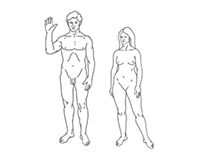A Migraine (Greek: ‘half skull’) is a neurological syndrome which often presents itself as a severe headache. There are different types of migraines, most give the sufferer a headache, and might make them dizzy or want to stay away from bright lights (photophobia) or loud noises (hyperacusis). They can also include visual disturbances (such as seeing funny patterns or lights/colors) and other disturbances of senses (funny smells or tastes). Migraines can last from 4 to 72 hours, but in most cases only last about 4 hours. The cause of migraines is unknown, but it is often believed to be linked to family medical history. It is about three times more common in women than in men.
The typical migraine headache is unilateral pain (affecting one half of the head) and pulsating in nature. Approximately one-third of people who suffer from migraine headaches perceive an aura—unusual visual, olfactory, or other sensory experiences that are a sign that the migraine will soon occur. Initial treatment is with analgesics for the headache, an antiemetic for the nausea, and the avoidance of triggering conditions. The cause of migraine headache is unknown; the most common theory is a disorder of the serotonergic control system.
The Daily Omnivore
Everything is Interesting



Leave a comment